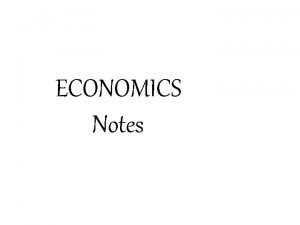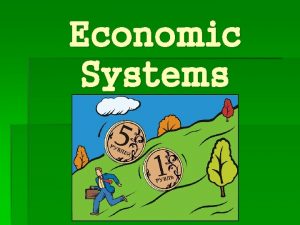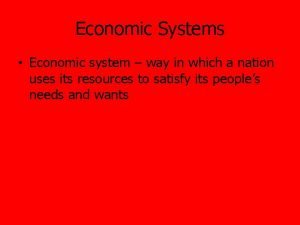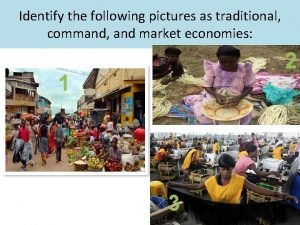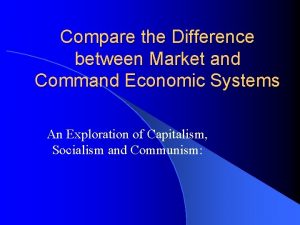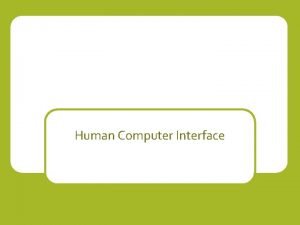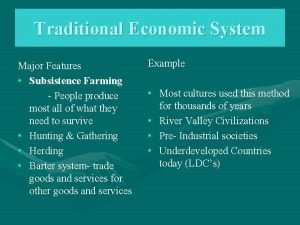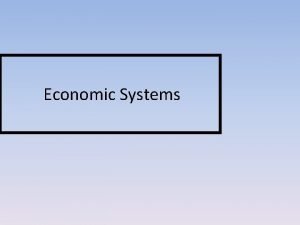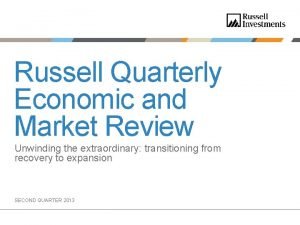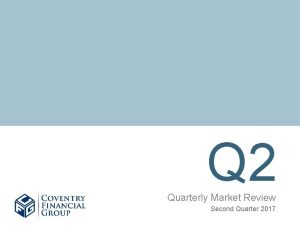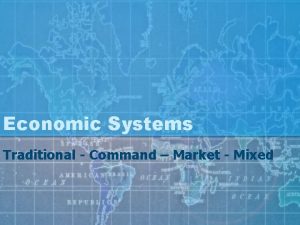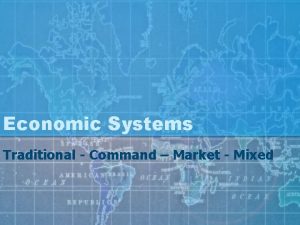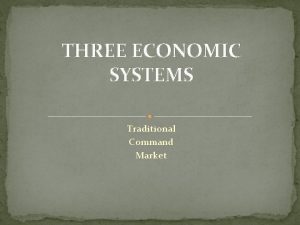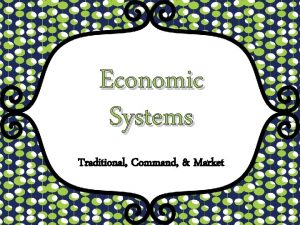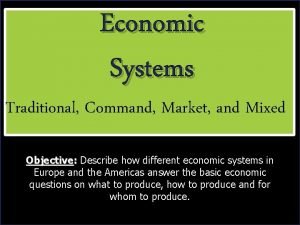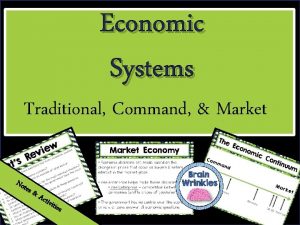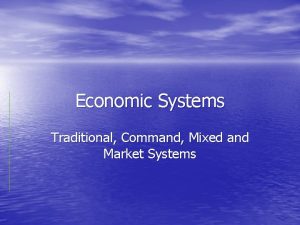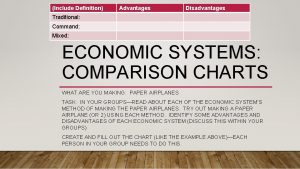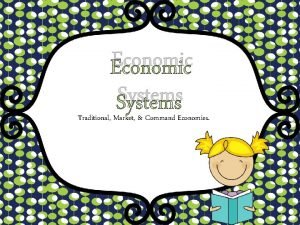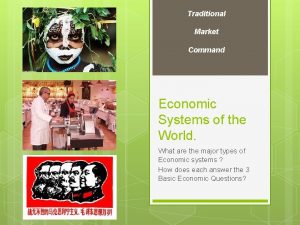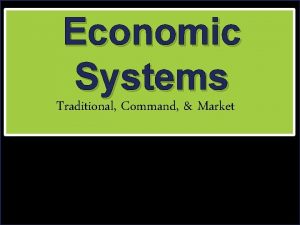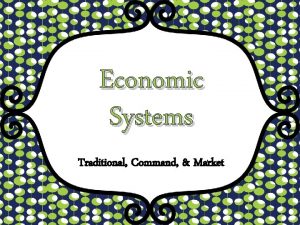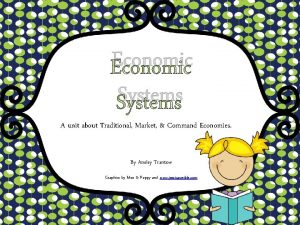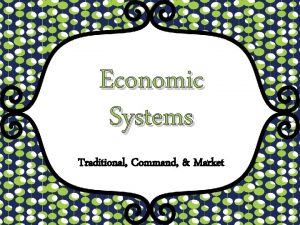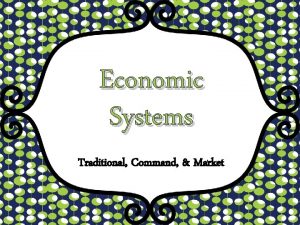Economic Systems Traditional Command Market Traditional u Advantages


















- Slides: 18

Economic Systems Traditional Command Market

Traditional u Advantages – 3 questions answered u Disadvantages – no progress, no personal freedom to make decisions

Command u Advantages – can change quickly, many public and health services available at little or no cost u Disadvantages – not designed to meet the needs of individuals, no incentive, large bureaucracy (slow decision making and costly), rigid, no new ideas u **North Korea – (Pure command), Cuba, Vietnam, Venezuela, the former USSR

u. A market is an arrangement where buyers and sellers interact to determine the prices and quantities of goods and services u Market economies are often described as being based on capitalism - an economic system where private citizens own and use the factors of production for their own profit u ** Australia, Canada, GB, Japan, Singapore, South Korea, US

Market Economy u u u Advantages – can adjust to change, individual freedom, little government interference, decentralized government, large variety of goods/services, satisfaction Disadvantages – does not provide for everyone, not enough of services we value (national defense, education, health care), uncertainty Does not provide for everyone Does not provide enough of the services that are valued Uncertainty Can fail – to avoid must have competition, resource mobility and informed consumers

Mixed Economies u. A system that has characteristics of more than one system/ a blend of systems. u The US – prior to the Great Depression the US was a free market/ after the crash no-free systems were implemented – minimum wage, unemployment insurance, Social Security, price supports for agriculture

Throughout most of the 1900 s, the world’s developed nations fell into three categories of economic systems– communism, socialism, and capitalism u Communist countries were closely associated with command economies, capitalist countries were most similar to market economies, and socialist countries had a combination of both command market economies. u u Sweden is an example of a country with a strong socialist tradition, and the high taxes that go along with it.

u The three basic types of economic systems can be illustrated in a spectrum

Introduction (cont. ) Section 1 -5 • The three basic types of economic systems can be illustrated in a spectrum. 9

u • At the far right is capitalism, in which government has a limited role As one moves from left to right along the spectrum, both the ownership of resources and the degree of government involvement in the operation of the economy change. • No lines separate communism, socialism, and capitalism. • They appear on the spectrum as having a greater or lesser degree of government involvement and private ownership of resources.

u The word capital, meaning “wealth, ” comes from the Latin word caput, meaning “head, ” and a time when someone’s wealth was based on how many head of cattle that person owned. The term per capita, meaning “per head, ” comes from the same source.

u The means of production are privately owned. u Supply and demand determine prices. u Businesses are free to direct resources into profitable activities. u Advantages of capitalism include efficiency, freedom, decentralization, a smaller role for government, and a high degree of consumer satisfaction.

GDP (gross domestic product) u GDP per capita (per person) – most reliable measure of a countries wealth, the dollar value of all production in a nation over a year

Capitalism and Economic Freedom u Capitalism – private citizens own the factors of production u Free enterprise – describes an economy in which competition is allowed to flourish with a minimum of government interference.

Economic Goals Freedom – freedom to use your resources however you please u Efficiency – not wasting resources u Equity – justice, fairness u Security – safety nets u Full Employment – people working so that they can support themselves u Stability – limited inflation u Economic Growth – continued growth u

u Future u Trade Goals Offs – forfeiting one goal to ensure another is met

Free Enterprise Economy u 5 characteristics u Economic freedom u Voluntary exchange u Private property rights u Profit motive u competition

u Entrepreneur – organizes and manages land, capital, and labor in order to seed rewards called profit u Consumer – have the power (consumer sovereignty) u Government – has several different roles: protector, provider & consumer, regulator and promoter of national goals.
 Lesson 2 our economic choices
Lesson 2 our economic choices Market leader challenger follower nicher examples
Market leader challenger follower nicher examples Positioning targeting and segmentation
Positioning targeting and segmentation Define command economy
Define command economy What is command economic system
What is command economic system Command economy
Command economy Pictures of traditional economy
Pictures of traditional economy Economic growth vs economic development
Economic growth vs economic development Conclusion of growth and development
Conclusion of growth and development Similarities between market and command economy
Similarities between market and command economy Market vs command economy
Market vs command economy What are the advantages of command line interface
What are the advantages of command line interface Traditional economic system example
Traditional economic system example Features of economic system
Features of economic system Traditional economic system example
Traditional economic system example Russell quarterly economic and market review
Russell quarterly economic and market review Yang fin
Yang fin Russell quarterly economic and market review
Russell quarterly economic and market review Africa's economic systems comprehension check answer key
Africa's economic systems comprehension check answer key



